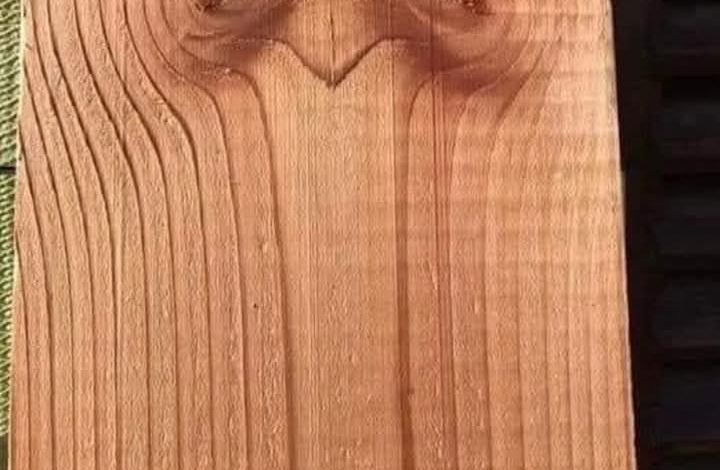
ADVERTISEMENT
The Art of Nature: Exploring Patterns and Faces in Wood Grain
Introduction
Nature has an incredible way of surprising us with its artistic creations, often in the most unexpected places. The image of a wooden plank displaying a face-like pattern in its grain is a fascinating example of pareidolia—the tendency of the human brain to perceive familiar shapes, such as faces, in random objects. This unique occurrence in wood grain captures the imagination and reminds us of the beauty and wonder inherent in natural materials. In this article, we delve into the science, artistry, and cultural significance of these naturally occurring patterns in wood.
Understanding Wood Grain Patterns
Wood grain patterns are the result of a tree’s growth rings, knots, and natural variations in its structure. Each tree tells a story through its grain, reflecting its age, environmental conditions, and even the challenges it faced during its growth.
The “face” visible in the wooden plank likely comes from a knot—a spot where a branch once grew. Knots occur when a tree’s trunk surrounds the base of a branch as it grows. Over time, these knots can form intriguing shapes, like the one in the image, which resembles a nose, eyes, and even a mouth. The unique grain lines further enhance the illusion, making the “face” appear lifelike.
The Science of Pareidolia
Pareidolia is a psychological phenomenon that causes people to see familiar objects or patterns in unrelated stimuli. It’s the same mechanism that allows us to see shapes in clouds or faces in rock formations. This tendency is deeply rooted in our evolutionary history, as recognizing faces quickly was crucial for survival.
ADVERTISEMENT
The wooden plank in the image is a perfect example of pareidolia at work. While the face is a coincidental arrangement of natural patterns, it feels intentional, evoking curiosity and even amusement.
Art and Inspiration in Nature
Patterns in wood grain have long inspired artists, carpenters, and designers. The unique designs found in wood are often celebrated in furniture making, decorative paneling, and other forms of craftsmanship. The face-like grain in this plank could easily be preserved as a centerpiece in a project, such as a tabletop or a wall hanging, turning a simple piece of wood into a conversation starter.
These natural “artworks” remind us of the importance of appreciating raw materials for their inherent beauty. Each piece of wood is unique, and finding patterns like the one in the image adds a sense of wonder to otherwise ordinary objects.
Cultural Significance of Patterns in Wood
In many cultures, wood is seen as a living material with its own spirit and story. Patterns like those in the image are often viewed as signs or symbols, sparking interpretations ranging from spiritual messages to simple good luck.
The face in the wood grain could also be seen as a connection to the tree’s life and history, making the material feel more alive and personal. For those who work with wood, these patterns serve as reminders of the respect and care owed to this natural resource.
ADVERTISEMENT
Conclusion
The face-like pattern in the wood grain is a striking example of nature’s ability to surprise and delight us. It showcases the artistry hidden within the natural world, waiting to be discovered by a curious eye. Whether seen as a coincidence, a work of art, or a playful reminder of nature’s creativity, such patterns remind us to appreciate the beauty in everyday materials.
Next time you encounter a wooden plank, take a closer look—you might just find a hidden masterpiece etched into its grain. This simple yet captivating phenomenon encourages us to pause, observe, and marvel at the natural world around us.
Title: The Art of Nature: Exploring Patterns and Faces in Wood Grain
ADVERTISEMENT




